Near the center of the US’s Mojave Desert is Joshua Tree National Park, where untamed landscapes stretch as far as the eye can see. Unlike many of California’s other national parks, there’s much development inside Joshua Tree — there are no hotels, no shuttle system, no restaurants, and really, not even that many roads. And the towns around the borders of Joshua Tree aren’t exactly highly populated, either.

A First-Timers Guide to a Joshua Tree Stargazing Trip
That combination of minimal development in the park and small, remote communities outside the park makes Joshua Tree stargazing some of the very best in North America. The park is a haven for stargazers, where the evenings play host to a celestial symphony almost every night. And that magnificent show begins with an equally magnificent sunset as the sky turns shades of pink and orange, interrupted only by the outline of the the park’s distinctive Joshua trees and massive boulder piles.
This is part of the reason Joshua Tree is an International Dark Sky Park, one of only 117 in the world (and 88 in the US). It’s a designation given by the Dark Sky Association to places that “possess an exceptional or distinguished quality of starry nights and a nocturnal environment that is specifically protected for its scientific, natural, or educational value, its cultural heritage, and/or public enjoyment.” In other words, Joshua Tree stargazing is exceptionally good, with extremely dark skies and absolutely jaw-dropping surroundings.
For visitors keen to witness Joshua Tree’s nocturnal spectacles, just about anywhere in or around the park will feel like your own personal observatory. But if you want to do a Joshua Tree stargazing trip like a pro, all you need is some basic information to make sure you make the best of your (night)time in the stunning desert expanse.
How to get to Joshua Tree
Joshua Tree is in southern California and has no public transportation. It’s near Palm Springs and Anza-Borrego Desert State Park, which is also a well-known stargazing location. You’ll need a car to visit the park, which you can rent in LA (a two-hour drive), in Palm Springs (a 40-minute drive), or in San Diego (a three-hour drive).
There’s also no shuttle service within the park, so you’ll need to drive to get around. Note that many of the roads in Joshua Tree are considered “backcountry roads.” This means they’re in rough condition, have no services or amenities along the way, and may require some off-roading and maneuvering around rocks and potholes. There are very specific rules about driving on the park’s backcountry roads, but since many of the best stargazing spots are accessed via these roads, it’s worth exploring a few. They’re not as rough as roads in other parks with unmaintained roads, like Big Bend or Death Valley.
In Joshua Tree, all the roads are all well-marked on maps and easy to follow. The maps also show which roads are maintained and which aren’t, in case you want to avoid rough roads entirely.
Joshua Tree stargazing events
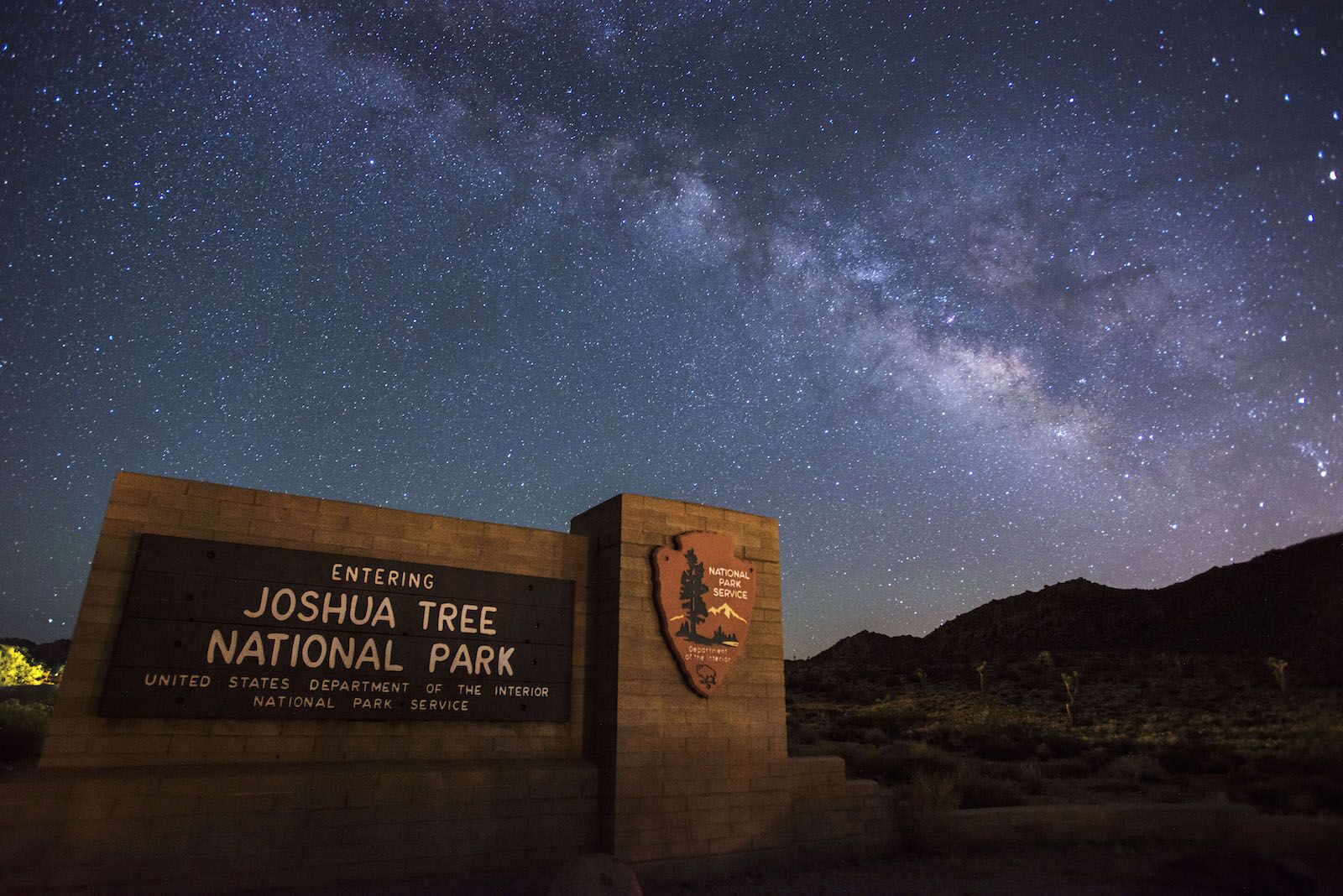
Photo: NPS/Lian Law/Public Domain
The park hosts multiple night sky events throughout the year, all of which are open to the public.
In the summer, the only evening events are the “Evening Program at Jumbo Rocks” (a park campsite with a large amphitheater). In 2023, the program is offered once a week and starts at 8 PM. The rangers are free to discuss whatever about the park they find most interesting, which could include stargazing.
But in fall, winter, and spring, there are more ranger and public programs offered (summer is the park’s low season). When you enter the park, you’ll be given a park newspaper, which will have all the activities going on during your visit. If you’re hoping to catch a night sky presentation or two, you’ll likely want to snag a campsite, so you can hang out after the presentation is done and not have a long drive ahead of you to exit the park. It takes about 15-20 minutes for your eyes to adjust to darkness, so it’s not an activity you really want to rush.
The park also partners with the Joshua Tree Desert Institute to offer classes for guests within the park boundaries. The institute offers a handful of photography classes throughout the year, including classes on how to shoot star trails, how to shoot the Milky Way, and how to shoot photos by moonlight only. Price for classes through the institute start around $60 and should be booked in advance online.
Night Sky tours in Joshua Tree
The entire desert in and around Joshua Tree is ideal for stargazing, and you can find stargazing tours in some of the area towns. That includes the actual town of Joshua Tree (near, but not in, the park) and nearby towns like Twentynine Palms. Guided tours are an easy way to see the night sky with a professional who can help you learn to identify what you’re seeing — and provide telescopes and the insider knowledge to know the very best spots.
Sky Watcher Star Tours offers super-hip stargazing sessions inside Joshua Tree National Park. Book a private or public experience, and you’ll get access not just to the best Joshua Tree stargazing location (a highly guarded secret), but also a picnic blanket with pillows, chairs, blankets, and snacks, plus a telescope and binoculars. Each sessions last two hours, during which time you’ll have a guide to help you navigate the night sky. The company has two locations and operates year-round.
For a slightly more unique experience, book a Joshua Tree stargazing experience with Addicted2Wonder. The company offers stargazing sessions guided by a Shaman where you’ll “learn the stars and philosophies of our elders by taking a fun and wildly different look at the night sky, one filled with laughter, suspense, wonderment, spiritual connection, story telling and the occasional ‘WTF is that?’ moments.” Tours are offered year-round, cost $150 per adult, and run for about 90 minutes.
Photographers may want to do some advanced planning and book a Milky Way Workshop. The one-night workshops are held through most of the summer and include an evening camera workshop, approximately six hours of night sky shooting with an expert, and an editing class the next day to help make the most of your photos. They’re priced at $399 per person (excluding lodge) and book months in advance. It’s one of several tours and programs available, so email Joshua Tree Workshops if you have questions or want to organize a private tour. Traveling through Joshua Tree and offering classes is a popular way for photographers to finance trips to the area, so you’ll usually find photography classes from someone available during your visit.
The Joshua Tree Night Sky Festival
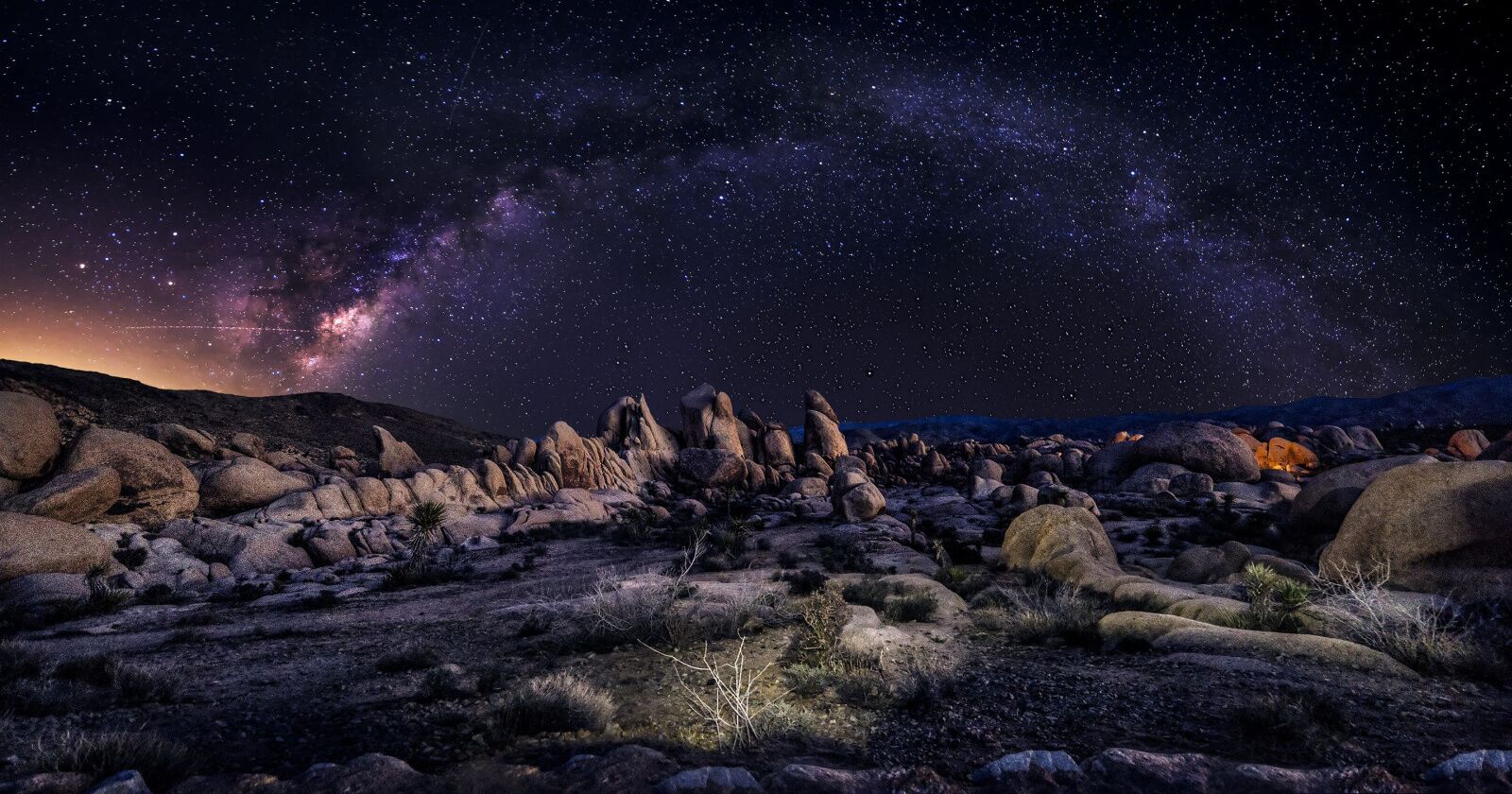
Photo: Rommel Canlas/Shutterstock
The Joshua Tree Night Sky Festival is an annual event celebrating the stars. It’s organized by the Sky’s The Limit Observatory and Nature Center and the Joshua Tree Residential Education Experience, in partnership with the park and the city of Twentynine Palms. It’s held every year in mid-October and is very popular, so as soon as you get your tickets, book your hotel or Airbnb, too, especially if you have a larger group.
The two-day festival is one of the most popular stargazing festivals in the country, with events like stargazing (naturally), astronomy lectures and presentations, photography and star ID workshops, guided night hikes, classes on how to use telescopes, and even quirkier activities like gold panning. Some activities are free, while others have individual fees. You can find the full run-down of events on the Sky’s the Limit festival page.
Where to find the best Joshua Tree stargazing
You can stargaze both inside and outside the park. The closer you get to any towns, the more light pollution you’ll have. But fortunately, most of the towns around Joshua Tree National Park are pretty small.
Joshua Tree stargazing inside the park
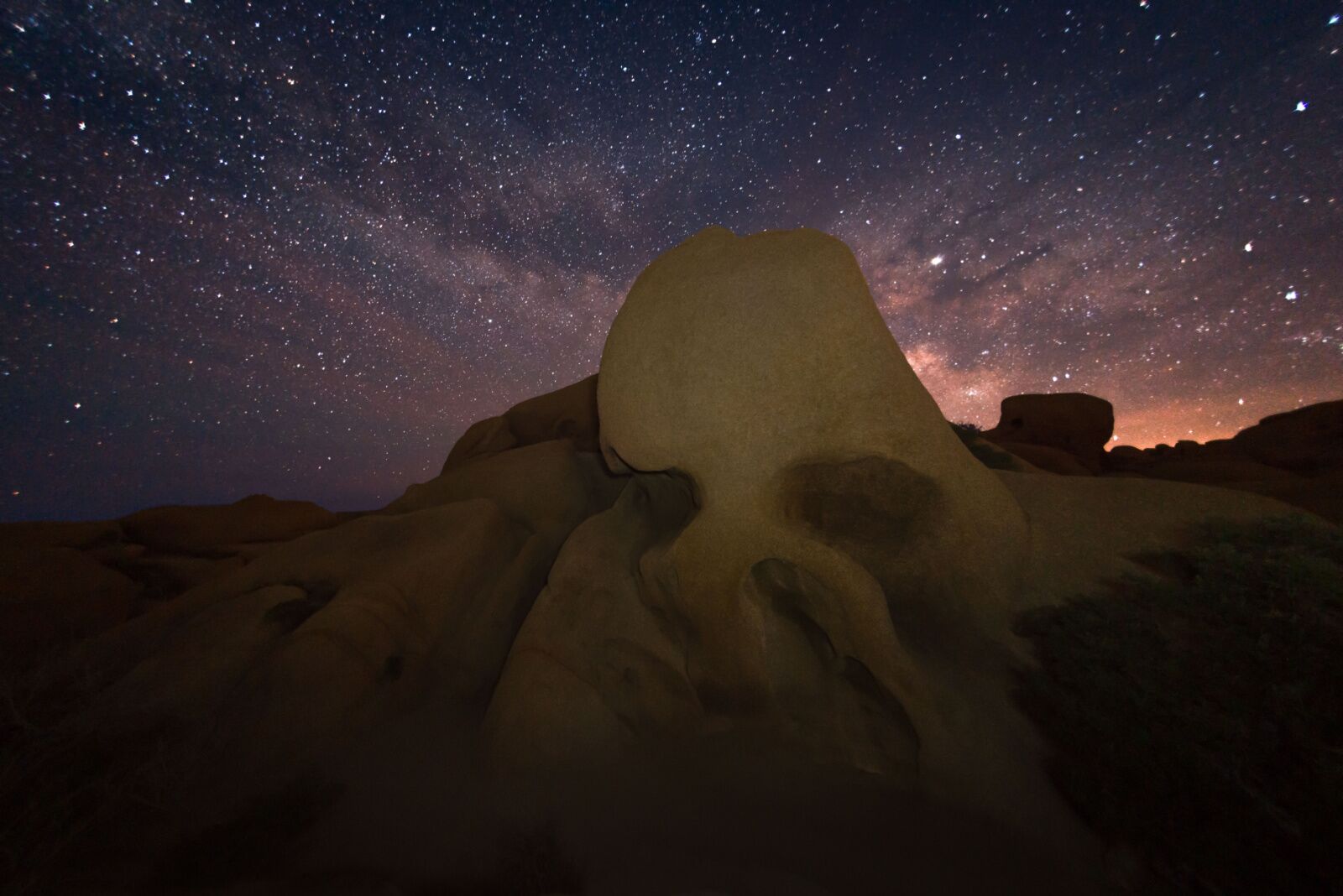
Photo: Sierralara/Shutterstock
Realistically, there’s no a bad spot in the park — though for a more peaceful Joshua Tree stargazing experience, you’ll probably want to be at least a few yards from other groups to give everyone a bit of silence, rather than hearing the sounds of kids or conversations next to you.
- Cottonwood Canyon Campground: For the perfect mix of night sky wonder and comfort, book a campsite at Cottonwood Campground, near the park’s southern entrance. It has 60 sites, all of which require reservations. It’s known for having the darkest skies in the park, and if you have a tent with a rainfly, you can leave it off for a night and watch the stars as you fall asleep (just make sure there’s no rain in the forecast). Sites are $25 per night.
- Skull Rock: Skull Rock is one of the most popular places for Joshua Tree stargazing as it’s very close to the road and has a very distinct shape: it looks like a skull. There’s a parking lot across the street from the rock and the road to reach is it maintained and easy to drive. It’s close to Jumbo Rocks campground, if you want to camp nearby.
- The backcountry: You can go, well, just about anywhere in the backcountry and see a phenomenal night sky show. You’ll need to secure a backcountry permit ahead of time online via Recreation.gov. If you’re heading on a backpacking trip specifically for stargazing, you may want to consider choosing a slightly shorter route than you normally would so you can add the extra weight of a small telescope, tripod, and wide-angle lens, if night sky photography is your thing.
- Keys View: Keys View is a very popular point in the park for stargazing as it’s a very short (.1-mile) walk to the lookout point. It sits more than 5,000 feet above sea level and has unobstructed views of the sky, plus excellent views of the surrounding peaks. You can see well into Mexico, and the parking area is just below the lookout. It’s about a 25-minute drive from the park’s western entrance.
- Cap Rock: Cap Rock is a popular stargazing area at the start of Keys View Road and a good choice if you don’t feel like driving all the way to the Keys View. It’s accessed via a quick .5-mile loop and is more or less in the center of the park.
Stargazing outside the park

Photo:
Joshua Tree may have a few towns outside the park boundaries, but most of them are very small, so light pollution is still quite minimal.
- Giant Rock: Giant Rock is, supposedly, the largest freestanding boulder in the world. Whether that’s true or not, it’s a great place for stargazing. The entire area around the rock is sandy and has lots of flat places to lay down a towel. Note that there are plenty of other rocks in the area, so you’ll want to go when the stars are directly above you and high on the horizon (summer) to ensure you have an unobstructed view. It’s about 19 miles north of Yucca Valley and attracts not just stargazers, but also people looking for UFOs and trying to feel the rock’s supposed spiritual powers.
- Mojave Trails National Monument: Take your pick of just about any spot in the Mojave Trails National Monument, which may soon qualify as its own Dark Sky Park, and you won’t be disappointed when the sun goes town. The monument is about 50 miles north of Joshua Tree. If its your first time, make your way to Kelso Rocks. Camping isn’t allowed, but hanging out to watch the sky is.
- The Sky’s the Limit Observatory: This cool facility is in Twentynine Palms, very close to the park. Once a month, it hosts a public astronomy program, scheduled for when the moon will be at its smallest. But the facility grounds are open all the time, so if you have your own telescope, you can visit whenever you’d like to stare at the heavens. Downloading a night sky app can be a helpful way to identify what you’e seeing, since there won’t be any guides on site outside of the official events.
- Anza Borrego State Park: This parks needs no intro to anyone who loves stargazing. It’s just as dark as Joshua Tree, with a program of stargazing events throughout the year. It’s about an hour and change south of the park and is where you’ll find Borrego Springs, the first Dark Sky Community in the US. Pick literally any spot in the park, or let an expert guide you from a a company like Borrego Night Sky Tours.
When to go stargazing in Joshua Tree
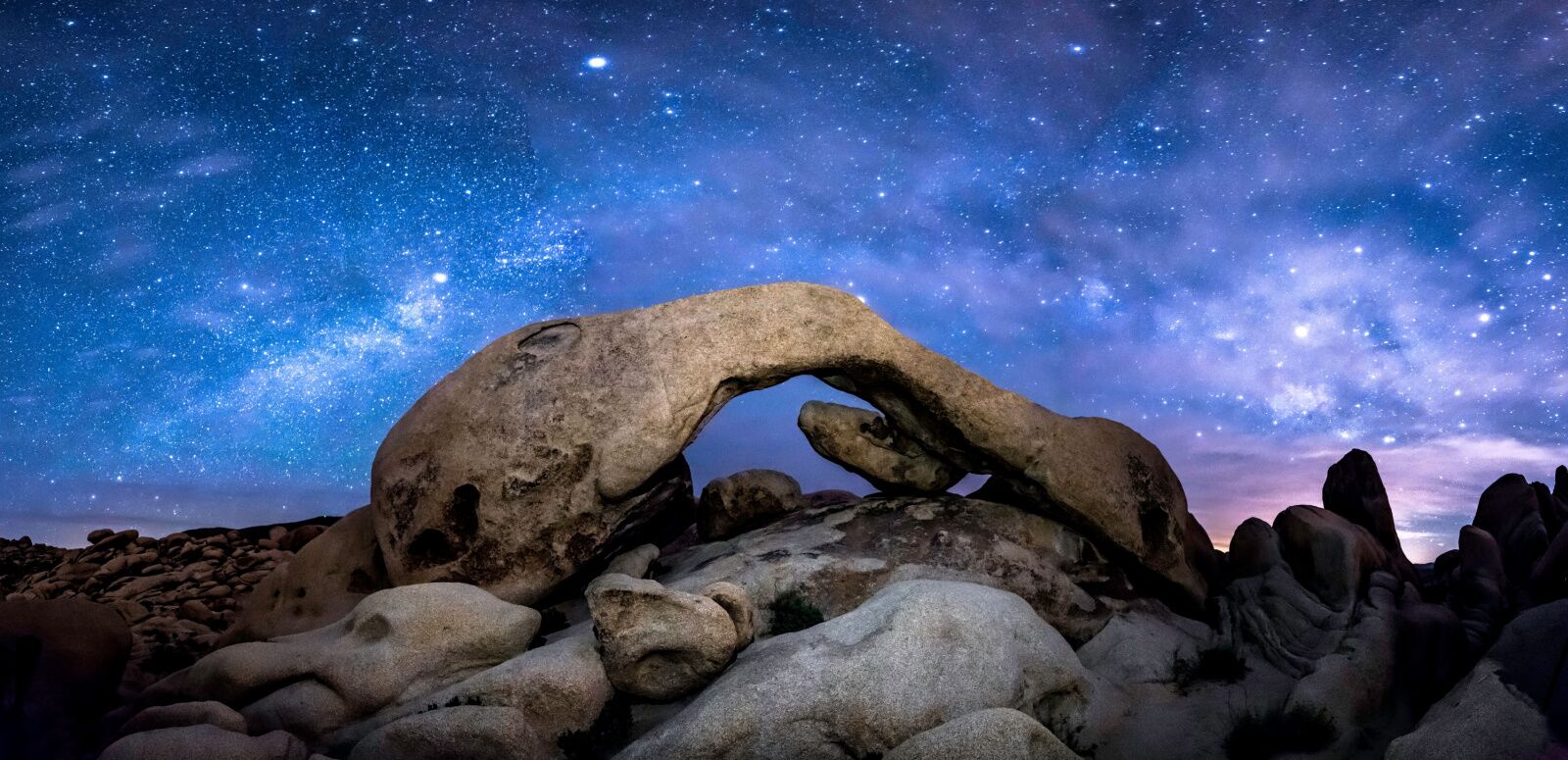
Photo: Joe Belanger/Shutterstock
The best time to go stargazing in Joshua Tree National Park for most people is during winter, since the nights are at their maximum length. That means it’s pitch black by 10 PM, making Joshua Tree stargazing far more convenient than in the summer, when the peak of darkness isn’t until 2 or 3 AM. Early spring and late fall can also be good. But since the entire park is an official “International Dark Sky Park,” you can count on clear skies and no light pollution year-round.
In the summer, you’ll need to prepared to stay up late, but the stars are still phenomenal. And in the middle of summer is when you’re most likely to see the Milky Way, no telescope needed. The downside is that you’ll also have to stay up late until the sky is at its darkest, but since summer can be unbearably hot in Joshua Tree, that’s actually a pretty good system: be active in the mornings and at night, avoiding any major activities in the middle of the day.
No matter when you go, try to pick a day when the moon is in an early phase, as a full moon can make it difficult to see the full celestial expanse. And remember that “good” and “not as good” are relative terms when it comes to Joshua Tree stargazing. If you’re coming from a city, you’ll see hundreds more stars, constellations, asteroids, and even satellites than you’d ever see on a regular night, even if you visit during a full moon or when the sky isn’t at maximum darkness.
The best hotels for Joshua Tree stargazing
Many hotels in Joshua Tree know that people come to the region because of its beautiful night skies and have stargazing programs and features for guests. These are a few of the best, but you can find plenty of cool Joshua Tree Airbnbs with features like skylights and outdoor viewing patios.
We hope you love the spaces and stays we recommend! Just so you know, Matador may collect a small commission from the links on this page if you decide to book a stay. Listed prices are accurate as of the time of publication.
AutoCamp Joshua Tree
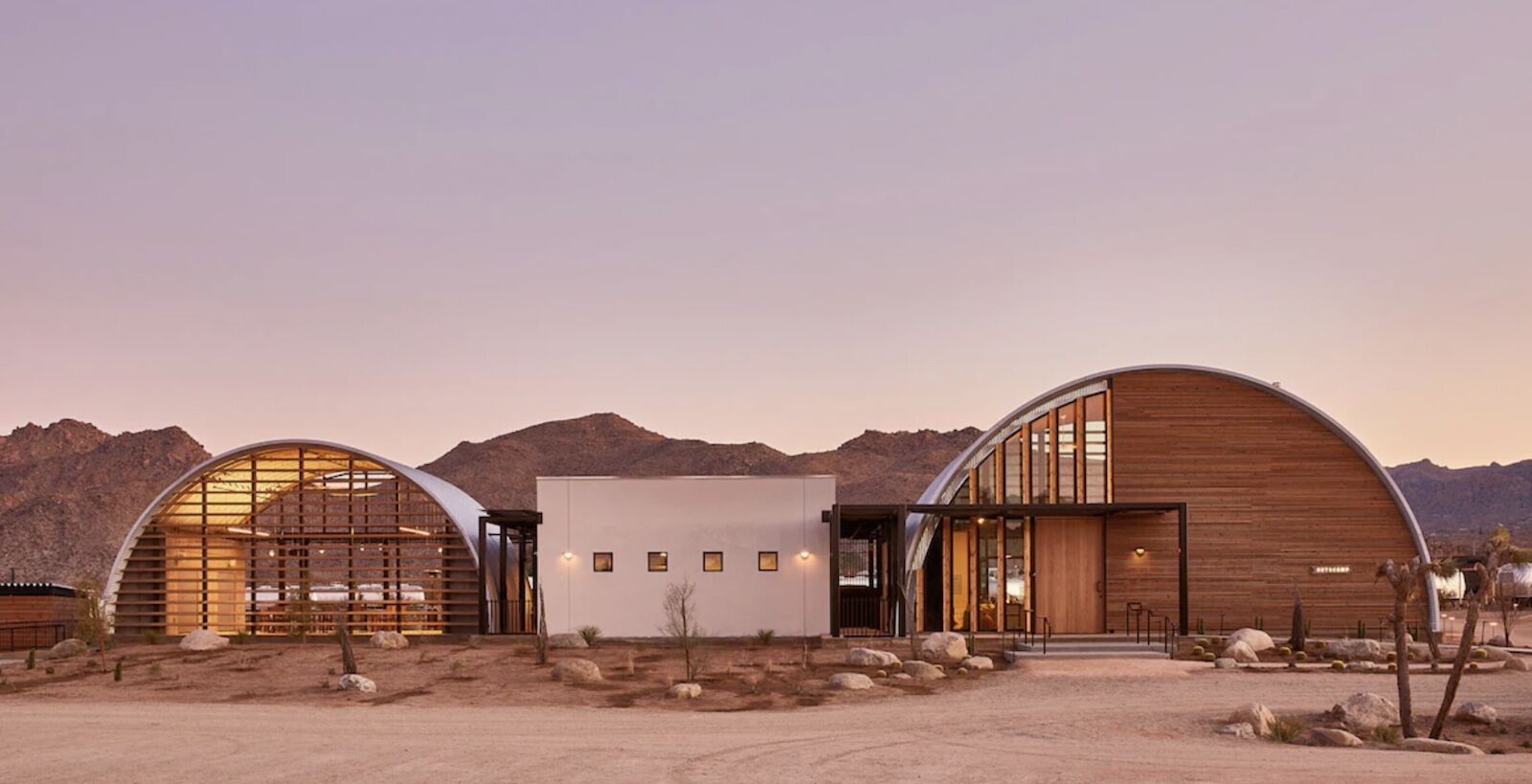
Photo: Expedia
The trendy AutoCamp Joshua Tree has custom Airstream trailers and modern cabins available to rent, which are cool enough unto themselves. But the best part for anyone interested in doing some Joshua Tree stargazing is that the hotel also offers multiple programs focused on the night sky, including new moon sound baths, full moon hikes (hey, it’s hard to hike when it’s pitch black), and free stargazing classes set the the backdrop of a cosmic-inspired playlist. Rooms start around $246 per night.
Sacred Sands Guest House
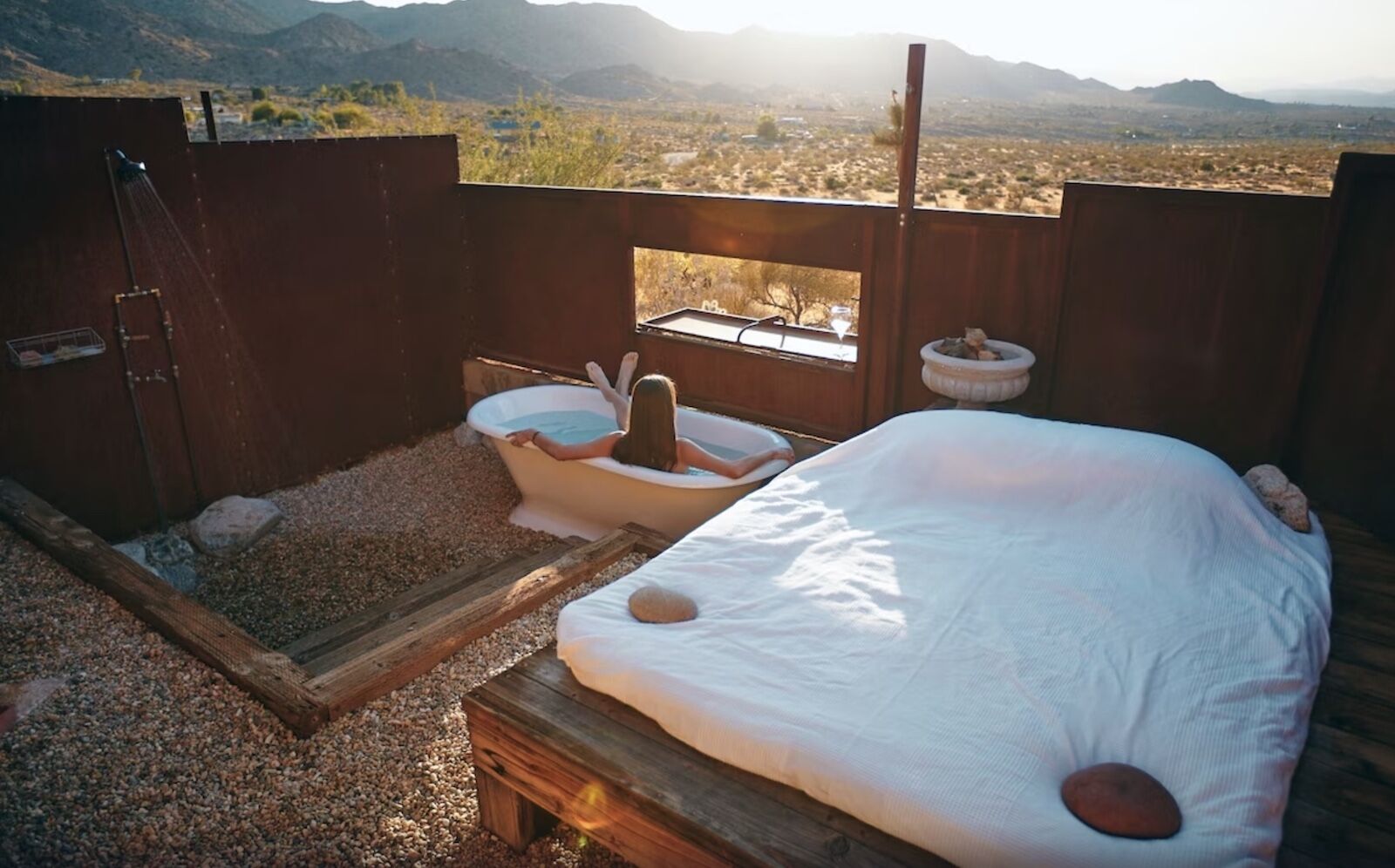
Photo: Expedia
Sacred Sounds is a small hotel/guesthouse bordering Joshua Tree National Park. The property has a high-end Bohemian feel, with earthy colors and features like record players and a terrace with a mediation platform. But the best part about the home is that both room (yes, there are only two!) have big outdoor areas with clawfoot bathtubs and outdoor beds, so you can watch the stars while staying warm and toasty. Rooms start around $321 per night.
Architects Stargazing Cabin
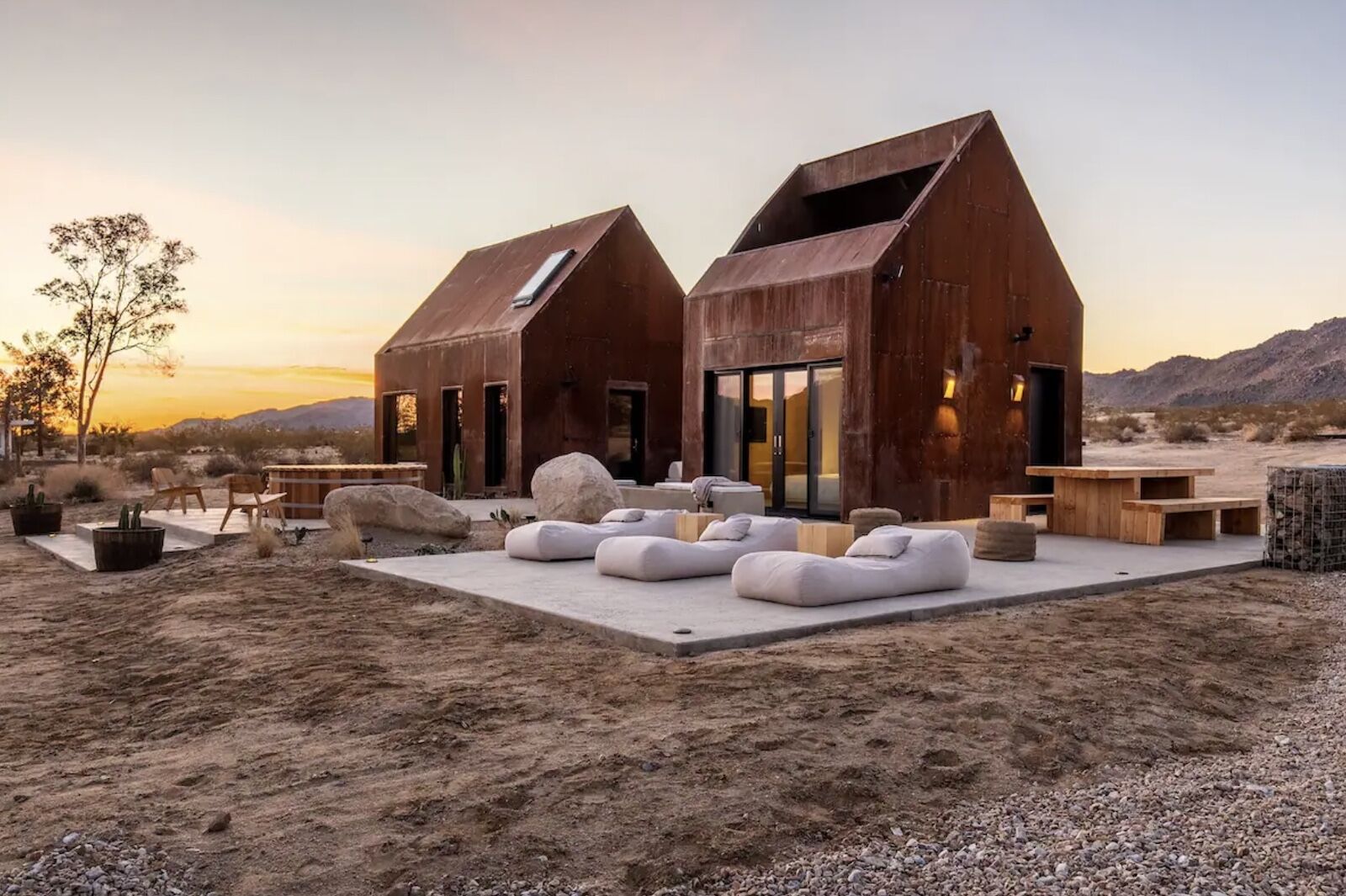
Photo: Airbnb
It’s a splurge, but if you want to maximize your chances for a romantic stargazing encounter, book this stunning cabin in the desert outside Joshua Tree. The interiors are hip and modern, but really, you’re there for the outdoor amenities — and there are many outdoor amenities. That includes a lofted outdoor bed with an open roof so you can stargazing from beneath the sheets, a bocce ball court, a hot tub with unobstructed views, and an outdoor living room with multiple lounge areas. It can fit four comfortable, though it’s a romantic place for a Joshua Tree stargazing getaway for two. Rates start in the $600s per night.